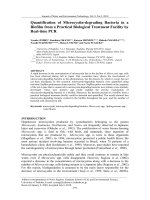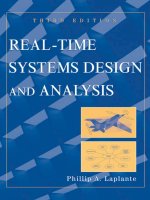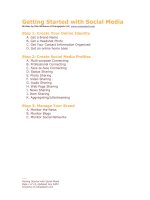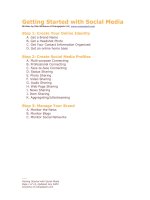Real time systems development by rob williams
Bạn đang xem bản rút gọn của tài liệu. Xem và tải ngay bản đầy đủ của tài liệu tại đây (2.24 MB, 468 trang )
Real-Time Systems Development
This page intentionally left blank
Real-Time Systems Development
Rob Williams
AMSTERDAM • BOSTON • HEIDELBERG • LONDON • NEW YORK • OXFORD
PARIS • SAN DIEGO • SAN FRANCISCO • SINGAPORE • SYDNEY • TOKYO
Butterworth-Heinemann is an imprint of Elsevier
Butterworth-Heinemann is an imprint of Elsevier
Linacre House, Jordan Hill, Oxford OX2 8DP
30 Corporate Drive, Suite 400, Burlington MA 01803
First published 2006
Copyright c 2006, Rob Williams. All rights reserved
The right of Rob Williams to be identified as the author of this work has been asserted in
accordance with the Copyright, Designs and Patents Act 1988
No part of this publication may be reproduced in any material form (including photocopying
or storing in any medium by electronic means and whether or not transiently or incidentally
to some other use of this publication) without the written permission of the copyright holder
except in accordance with the provisions of the Copyright, Designs and Patents Act 1988 or
under the terms of a licence issued by the Copyright Licensing Agency Ltd, 90 Tottenham
Court Road, London, England W1T 4LP. Applications for the copyright holder’s written
permission to reproduce any part of this publication should be addressed to the publisher
Permissions may be sought directly from Elsevier’s Science and Technology Rights
Department in Oxford, UK: phone: (+44) (0) 1865 843830; fax: (+44) (0) 1865 853333;
e-mail: You may also complete your request on-line via the
Elsevier homepage (www.elsevier.com), by selecting ‘Customer Support’ and then
‘Obtaining Permissions’
British Library Cataloguing in Publication Data
A catalogue record for this book is available from the British Library
Library of Congress Cataloguing in Publication Data
A catalogue record for this title is available from the Library of Congress
ISBN-13: 978-0-7506-6471-4
ISBN-10: 0-7506-6471-1
For information on all Butterworth-Heinemann publications
visit our website at
Typeset by Charon Tec Pvt. Ltd, Chennai, India
www.charontec.com
Printed and bound in Great Britain
Contents
Preface
Recommended lab sessions
Acknowledgements and thanks
1
2
3
4
5
6
7
8
9
10
11
12
13
14
15
16
17
18
19
20
vii
ix
xi
Introduction to real-time systems
Implementing simple real-time systems
Basic input and output
Cyclic executives for bare hardware
Finite state machines – design tool
Finite state machines – implementation options
Why multi-task?
Task communication and synchronization
Real-time executives
Using input/output interfaces
Structured design for real-time systems
Designing for multi-tasking
UML for real-time systems
Object-oriented approach for real-time systems
System integrity
Languages for RTS development – C, Ada and Java
Cross-development techniques
Microcontroller embedded systems
Linux device drivers
Hardware/software co-design
Appendix A: Using an oscilloscope for software debugging
Index
v
1
29
46
81
94
110
150
169
201
224
241
267
285
297
311
341
358
393
410
435
445
451
This page intentionally left blank
Preface
As more and more of our daily technology depends on embedded microprocessors, the demand for good real-time software has grown enormously.
So it is unfortunate that computer science students frequently only develop
and run programs on standard desktop Windows platforms. This leaves them
somewhat unprepared for the extra problems encountered should they end
up producing code for a new DVD player, a mobile handset or an Internet
packet router. This text reveals some of the particular difficulties encountered
when designing for real-time systems, and the alternative routes available for
software realization. It is perhaps a shame that so few programmers have
the opportunity to study the science and art of real-time systems before
being confronted by their first real-time project. As a large proportion of new
domestic and leisure equipment relies on microprocessors for basic operations,
the world might be a safer and less frustrating experience for all of us if this
situation could be rectified.
My own commercial experience in the field of microprocessor applications influenced my academic direction when I returned to university life.
It had struck me that the normal computer science courses did not cover
enough basic material in low-level programming and electronics which was
necessary to support a career in real-time, embedded development. There
had also been a continuing trend to separate the study of hardware from
software, reducing students’ ability to understand the operational totality of
microprocessor-based systems. When debugging faulty equipment, computing graduates suffered from a serious disadvantage. Should they require some
more graphical evidence from their limping software, they dared not turn on
an oscilloscope. On the other side of the fence, electronic engineers scratched
away at assembler spaghetti code, or naively marvelled at the irredeemable
wonders of Basic.
What was needed was a synthesis of the two disciplines, a harmonization
of software and electronic engineering. With this in mind we proposed and
validated the BSc Computing for Real-time Systems. This text came from the
experience of teaching on that four-year honours programme. It represents
the content of a two-semester, senior year module called ‘Real-time Systems
vii
viii
Preface
Design’ which we have presented to our undergraduates, in a variety of evolving versions, for 20 years. It has also been delivered in a modified, accelerated
form as a masters-level module within our MSc Software Engineering. On the
whole, students enjoy the module, and manage to gain considerable benefit
from the down-to-earth approach and practical challenges.
Recommended lab sessions
It is anticipated that the majority of the readers of this text will be advanced
undergraduates or masters-level students pursuing a course called Computer
Science, Computing, Software Engineering, or some similar title. They will
probably have chosen to take an option in Real-time Systems Design, or
Development. Such modules normally include weekly lectures and practical
work in laboratories. So, the material covered in the following chapters represents only one component of their learning experience. The following list
of extended practical exercises is not a recommended schedule for a single
semester’s laboratory activity because each individual student will bring different experience and skills to the course. They have different ambitions and
expectations, so what they actually decide to do during the practical sessions
will vary. A variety and choice of laboratory work is always a popular factor
with students.
1.
2.
3.
4.
5.
6.
7.
8.
9.
10.
Introduction to I/O programming with Linux
Real-time motor control
Finite state methodology
SA/SD, real-time Yourdon, case study
OOD, case study
Configuring gcc cross-compilers
Cross-development methods
Synchronization and communications
Petri net methods
Point Of Sale (POS) network case study
An alternative and very effective strategy is to organize an extended case
study project, which involves design, implementation and test activities. This
develops and extends the students’ understanding throughout the semester,
and can be subdivided into component parts for each member of the team.
In this way, a wide range of technical skills and interests, from embedded
microcontrollers to Oracle database servers, can be integrated into a single project, and assessed partly individually and partly as a team. Such
ix
x
Recommended lab sessions
activity offers the extra benefit of enabling groups to work together on a
much larger assignment, certainly an important experience for undergraduate
students. A suitable idea which we have used recently is the development of
a POS network, with POS terminals, data concentrator and central database
server. This supplies a broad scope for design variation and allows for regular
enhancement to keep the technology up to date.
Acknowledgements and thanks
There are many individuals, colleagues, students and graduates from our
BSc Computing for Real-time Systems degree, who have contributed to this
text, directly or indirectly. In particular I would like to thank a colleague
Bob Lang who generously provided detailed, technical reviews of all the
chapters, based partly on his own commercial experience working with realtime systems. Also, Craig Duffy tolerating the repeated requests to read
drafts and responded with a sustained counterstream of cross-development
news from his Linux porting activities. In addition, I have enjoyed useful
discussions on many real-time topics with Richard Barry, Adam Budd, Andy
Clymer, Mark Cridge, Tony Gibbs, Will Skinner, and Rob Voisey. They may
recognize their influence in some parts of the book.
The duckshoot game, among many other ideas, was lucidly explained to
me many years ago by Jonathan Bromley, and it has survived to provide an
intriguing programming exercise. I must also warmly thank my colleagues
Jeff Graham, Nigel Gunton, Ian Johnson, Peter Martin, Laurence O’Brien
and Chris Wallace for engaging so generously in technical discussions and
accepting the regular outbreaks of author’s obsession.
There are too many students to mention individually, but throughout
the past 20 years, they have trusted us with their careers by enrolling onto
our BSc Computing for Real-time Systems degree. Fundamentally, it is their
good humour and continuing curiosity which provided the spur for this text.
The best reward for any teacher is to see students progress and develop their
technical confidence, leading to successful graduation and rewarding careers.
I must also once again give praise to Brian Kernighan for his wonderfully
small pic language, which I used to construct all the line diagrams throughout
the book. The original text was edited with emacs and the formatting was
all carried out using groff from Richard Stallman’s GNU suite. It was here
that I discovered the fun of using pic to code diagrams. I would also like
to thank Richard Stallman for the guidance he generously offered concerning
the General Public License which is discussed in Section 9.13.
The book would not have been possible without the energy and persistence of the editors, initially David Hatter, and latterly Alfred Waller
xi
xii
Acknowledgements and thanks
at Elsevier. Many thanks to them both for their patient encouragement
throughout, and also to Deborah Puleston for her flawless and patient editing.
Finally credit and thanks to the my wife Val, who several times struggled
through the draft text, in a heroic effort to eliminate my worst grammatical
errors. Apologies to our cat Cassie who has not yet forgiven my purchase of
a flat panel screen, removing her favourite warm perch on top of the CRT.
I witnessed her discouraging encounter with modern technology as she
teetered on the top edge of the new LCD panel, and then slowly, silently
toppled backwards onto my keyboard.
Dr Rob Williams
UWE
Bristol
Chapter 1
Introduction to real-time systems
1.1 Chapter overview
The role of real-time software grows larger and larger, and in a competitive
marketplace any marginal improvement in usability or performance, provided
by more effective software, will give a significant sales advantage. This introductory chapter tries to outline the source of some of the problems which
programmers and engineers are likely to encounter and provides a set of
guidelines for identifying potential real-time systems by looking at a number of their characteristics. It also introduces associated key ideas through
example applications which, at this early stage, may be more helpful than
offering abstract principles.
1.2 Real-time systems development
Real-time processing normally requires both parallel activities and fast
response. In fact, the term ‘real-time’ is often used synonymously with
‘multi-tasking’ or ‘multi-threading’, although this is not strictly correct:
small real-time systems, as used in dedicated equipment controllers, can
perform perfectly adequately with just a simple looping program. Indeed,
the period I spent developing commercial embedded systems taught me that
such simplicity of design has much merit, and with the massive increase
in processor speeds, it is now possible to use such crude software schemes
for a much wider range of applications. As long as the response is good
enough, no further complexities need be introduced. But, if a large number of different inputs are being monitored by a single processor, or the
input data streams are complex and structured, the simple polling loop
approach will prove inflexible and slow, and a multi-tasking solution will
be required. Whatever style of implementation is chosen as appropriate,
the need remains to deal with several concurrent activities over a period
of time.
1
2
Real-time systems development
Real-time systems often seem like juggling
1.3 System complexity
A lot of the problems encountered with any software development involve
‘complexity management’. Good practice, prior experience and team work
are essential factors in achieving a successful outcome. Problems often appear
impossible until they are subdivided, then each component part becomes
much more manageable. Real-time software suffers from the same set of
problems as traditional DP (Data Processing) applications, but adds the
extra dimension of time to confuse the developer. To help in the preliminary
analysis and design work, a rigorous method, which can be understood by all
the team members, should be adopted. This will provide discipline and guidance. The main reason for undertaking design activity is to arrive at some
well-structured code. Design without a subsequent implementation is mostly
a futile activity. If you follow a good design technique, appropriate questions
will emerge at the right moment, disciplining your thought processes.
A design method should provide intellectual guidance for system partitioning as well as documentation standards to ensure you record your
decisions and supporting rationale. Without an effective method, you could
end up with the complexity of a bramble patch, as illustrated opposite.
Introduction to real-time systems
3
A very preliminary design schema illustrating complexity (thanks to Les Carleton)
Perhaps surprisingly, suitable alternatives for real-time systems design
are not very numerous. In this text we have selected: Structured Analysis/
Structured Design (SA/SD), Concurrent Design Approach for Real-time
Systems (CODARTS), Finite State Methods (FSM), and Object-Oriented
Design (OOD) for study. The actual tools used to solve problems clearly
constrain the set of solutions available, and so the choice of design method
is vital.
1.4 Microprocessors and real-time applications
We are all familiar with real-time applications, they surround us in our
everyday lives. Vending machines, mobile phones, alarm systems, washing
machines, motor car engine controllers, heart monitors, microwave ovens,
point-of-sale terminals, all operate courtesy of an embedded microcontroller
running dedicated software. Before microprocessors appeared in the late
1970s, such functionality, in as far as it was possible, was conferred by electronic circuits often built using 7400 series TTL logic packs. Each application
required a completely different circuit to be designed and manufactured. This
was not an attractive prospect for equipment suppliers who were struggling
to control their expanding warehouse stock levels, inflated by the gush of new
silicon products. The arrival of embedded software, which allowed many different applications to share the same hardware, was most welcome. The term
4
Real-time systems development
P
Enter car number first
Press for
ticket
Tariff
1hr 40p
Sun free
Sat free
Coins
A familiar real-time application
‘real-time’ is also used in the USA to describe on-line terminal services such
as ATMs (Automatic Teller Machines, or cash dispensers), database enquiry,
and on-line reservation and payment systems. Recently the term ‘responsive system’ has been introduced to further distinguish such computer-based
applications. The list expands as technology elaborates. In practice, all computer systems have some aspects which are relevant to real-time programming
and so the specific skills presented in this text are in great demand.
1.5 Definition of a real-time system
Although there is no clear dividing line between real-time and non-real-time
systems, there are a set of distinguishing features (listed below) which can
assist with an outline classification schema to identify real-time applications.
• Timing The most common definition of a real-time system involves a
statement similar to ‘Real-time systems are required to compute and
deliver correct results within a specified period of time.’ Does this mean
that a non-real-time system such as a payroll program, could print
salary cheques two years late, and be forgiven because it was not a
real-time system? Hardly so! Obviously there are time constraints on
non-real-time systems too. There are even circumstances in which the
Introduction to real-time systems
5
• Specified limit on system response latency
• Event-driven scheduling
• Low-level programming
• Software tightly coupled to special hardware
• Dedicated specialized function
• The computer may be inside a control loop
• Volatile variables
• Multi-tasking implementation
• Run-time scheduling
• Unpredictable environment
• System intended to run continuously
• Life-critical applications
Outline real-time categorization scheme
early delivery of a result could generate more problems than lateness
of delivery. A premature newspaper obituary could sometimes create as
much havoc as an early green on a traffic light controller.
Response time sensitivity
• Interrupt driven After the requirement for maximum response delay
times, the next characteristic of real-time systems is their involvement
with events. These often manifest themselves in terms of interrupt
signals arising from the arrival of data at an input port, or the ticking
Now!
Event-driven pre-emption
6
Real-time systems development
of a hardware clock, or an error status alarm. Because real-time systems are often closely coupled with special equipment (a situation that
is termed ‘embedded’) the programmer has also to gain a reasonable
understanding of the hardware if the project is to be a thorough success.
Once again, however, the demarcation between traditional data processing and real-time systems is not easy to draw because event-driven GUI
interfaces are so widely used within all desktop applications.
• Low-level programming The C language is still favourite for writing
device drivers for new hardware. But because high-level languages,
including C, do not generally have the necessary instructions to handle interrupt processing, it has been common for programmers to drop
down to assembler level to carry out this type of coding. Because ASM
and C are classified as low-level languages by many programmers, who
may be more familiar with database systems and windowing interfaces,
it has been suggested as a distinguishing characteristic of real-time programmers that they prefer to use low-level languages. This can be seen as
somewhat misleading, when the real-time high-level languages Modula-2
and ADA are taken into consideration.
• Specialized hardware Most real-time systems work within, or at least
close beside, specialized electronic and mechanical devices. Unfortunately, to make matters more difficult, during development these are
often only prototype models, with some doubt surrounding their functionality and reliability. This is especially true for small embedded
microcontrollers which may even be required to perform as critical component parts within a feedback control loop. The oven power controller
illustrated below could employ an integrated microcontroller to monitor
the oven temperature and adjust the electrical power accordingly. Such
applications place a heavy responsibility on the programmer to fully
understand the functional role of the software and its contribution to
the feedback delay which governs the system response. Code may have
to run synchronously with the hardware or other software systems, such
as when telephone transmissions are sequenced 8000 times a second to
maintain acceptable voice quality. Very often this leads the programmer
Desired
temp
Ϫ
ϩ
DAC
Heater
Driver
Oven
ADC
Signal
condn
Temperature
value
Feedback control loop for specialized hardware
Introduction to real-time systems
7
into other disciplines: electrical theory, mechanics, acoustics, physiology
or optics. Real-time programmers rarely have a routine day.
• Volatile data I/O Another special issue for real-time software concerns ‘volatile data’. These are variables which change their value from
moment to moment, due to the action of external devices or agents,
through interrupts or DMA. This is distinguished from the situation
where input data is obtained from a disk file, or from the keyboard under
program control. The most common example encountered by real-time
programmers involves input channels which operate autonomously to
bring in new values for memory variables when data arrives at an input
port. The software must then be structured to check for changes at the
correct rate, so as not to miss a data update.
CPU
System bus
Data
Volatile
data
I/O subsystem
Source
Count
Main memory
DMA controller
Data
Volatile variables with a DMA controller
• Multi-tasking Real-time systems are often expected to involve multi-
tasking. In this situation, several processes or tasks cooperate to carry
out the overall job. When considering this arrangement, there should
be a clear distinction drawn between the static aggregation of groups of
instructions into functions for compilation, and the dynamic sequencing
of tasks which takes place at run-time. It has already been suggested
that full multi-tasking is not always necessary, but it can be positively
advantageous to programmers in simplifying their work. It is also widely
accepted that many computer systems have become so complex that
it has become necessary to decompose them into components to help
people to understand and build them. In the traditional data processing
field, for example, the production of invoices from monthly accounts
requires several distinct operations to be carried out. These can be
sequenced, one after the other, in separate phases of processing. With
8
Real-time systems development
real-time systems this is rarely possible; the only way to partition the
work is to run components in parallel, or concurrently. Multi-tasking
provides one technique which can assist programmers to partition their
systems into manageable components which have delegated responsibility to carry out some part of the complete activity. Thus, multi-tasking,
although generally seen as an implementation strategy, can also offer an
intellectual tool to aid the designer.
T2
T3
T1
T4
Component sequencing
• Run-time scheduling The separation of an activity into several distinct,
semi-autonomous tasks leads to the question of task sequencing. In traditional DP applications the sequence planning is largely done by the
programmer. Functions are called in the correct order and the activity
is completed. But for real-time systems this is only half the story. The
major part of sequencing takes place at run-time, and is accomplished by
the operating system through the action of the scheduler. It is as if the
sequencing decisions have been deferred, it is a kind of ‘late sequencing’,
to draw a parallel with the established term ‘late binding’, used with
regard to code linking. This is perhaps the most interesting feature
of real-time systems. The manner in which the various activities are
evoked in the correct order is quite different from that of a traditional
DP system which normally relies on the arrival of data records from
an input file to sequence the functions, and so it is predetermined and
fixed.
• Unpredictability Being event driven, real-time systems are at the mercy
of unpredictable changes in their environments. It is just not feasible to
anticipate with 100 per cent certainty all the permutations of situations
which may arise. In my experience, the worst offenders are actually
the human users, who seem totally unable, or unwilling, to understand
what the designer intended. Any choice offered by a menu or sequence of
YES/NO alternatives will soon reveal unexpected outcomes during field
trials. The exact ordering or sequencing of all the functions which deal
with these interactions has to be decided at run-time by the scheduler,
giving much more flexibility in response. Considerable effort is now put
into extensive simulation testing in order to trap as many of these bugs
as possible, even before the designs are released.
Introduction to real-time systems
9
Unpredictability
• Life-critical code Although not always the case, real-time systems can
involve serious risk. A failure to run correctly may result in death or
at least injury to the user and others. Such applications are becoming
more and more common, with the aircraft and automobile industries
converting their products to ‘fly by wire’ processor technology. This
removes from the driver/pilot all direct, muscular control over the physical mechanism, relying entirely on digital control systems to carry out
their commands. The burden of developing real-time, life-critical software, with all the extra checking, documentation and acceptance trials
Life risking applications
10
Real-time systems development
required, may raise the cost beyond normal commercial projects, of
similar code complexity, by an astonishing factor of 30. Most real-time
applications are intended to run continuously, or at least until the user
turns off the power. Telephone exchanges, for example, contain millions of lines of real-time code, and are expected to run non-stop for 20
years. The increasing use of embedded microprocessors within medical
monitoring and life-support equipment, such as radiological scanners
and drug infusion pumps, makes consideration of software reliability
and systems integrity even more urgent. Some research effort has been
expended in devising a method to formally prove correct a computer
program, much in the same way that mathematicians deal with algebraic proofs. So far, the products resulting from this work have not
generated much commercial interest.
1.6 Programming structures
It is now well accepted that computer programs can all be broken down into
three fundamental structures:
• Linear sequences of instructions
• Iterative loops of instructions
• Branches guarded by selection statements
But as indicated above, the sequencing of real-time code is not straightforward. In addition, multi-tasking code requires two more structures:
• Parallel or concurrent instructions
• Critical groups of exclusive instructions
SEQ
IT
SEL
PAR
CRIT
More structures in real-time programs
While all DP systems may benefit from utilizing parallel or concurrent coding,
it is rarely essential, as it frequently is in the case of real-time systems. This
formally indicates the increased complexity that arises when working in the
real-time field.
Introduction to real-time systems
11
1.7 Response latency
There is also an interesting contradiction in citing ‘minimum response delay’
(latency) as the key factor when characterizing real-time systems. For
example, when using more sophisticated real-time executives (RTE), the full
response to a Receiver Ready or Transmitter Ready (RxRdy or TxRdy)
interrupt is often deferred in order to balance the processing load. Thus the
executive attempts to impose its own processing schedule on all the activities,
which can actually result in a delayed response. This could be seen as transforming unpredictable, asynchronous demands into scheduled, synchronous
processing.
Asynchronous
Unpredictable
events
Synchronous
Scheduled
processing
Rapid response compromised for processing efficiency
1.8 Relative speeds
1.8.1 Polling an input too fast
An important factor that needs to be clearly understood by newcomers to
real-time programming is the vast disparity in speed between the modern,
electronic computer and the human, physical world. Whereas even a slow
microcontroller will zip through instructions at a rate of 10 million per
second, humans can rarely handle a keyboard at two key strokes per second. The problem is due more to the relative speeds than their absolute
values. Such an enormous disparity in speed leaves programmers in quite a
quandary, since the voracious processing capacity of a modern CPU demands
to be fed at all times!
Consider the oscilloscope trace below, which shows how the output voltage
changes when a microswitch is closed. The contact bounces for a period of up
to one millisecond (1 ms, one thousandth of a second) before finally settling
down. Humans are not aware of this high speed dithering, but a computer,
sampling an input port one million times a second, can wrongly record that
the switch has been turned on and off several times when it has only been
pressed once.
Such errors often show up in ‘monitoring and counting’ systems and may
lead to the use of more expensive optical or magnetic switch units which do
not suffer from contact bounce.
12
Real-time systems development
Y:2.00 V/div
X:0.1 ms/div
Single
A1 STOP
Voltage from a key switch showing a contact bounce of nearly 1 ms
Alternatively, extra logic gates can be included to eliminate the effects of
contact bounce as shown below. But perhaps the best solution is to deploy
some debouncing software. This can subject the incoming, raw signals to lowpass filtering, at no extra expense. We will return to this issue in Chapter 4
with an example system.
5V
10 K
Mechanical switch
0V
Light
beam
Switch
Optical switch
Debouncing logic
1.8.2 Polling an input too slowly
It scarcely needs to be said that if a computer checks an input too infrequently
it runs the risk of missing an occasional event, such as a counting pulse. To
avoid this happening, it is common to require the sampling rate to be at least
twice as fast as the mean pulse frequency. If the system has to detect a pulse
occurring no more often than every 10 ms, the port should be checked at least
every 5 ms (200 times a second). Sometimes the input events are recorded
on a hardware latch in an attempt to reduce the required sampling rate.









